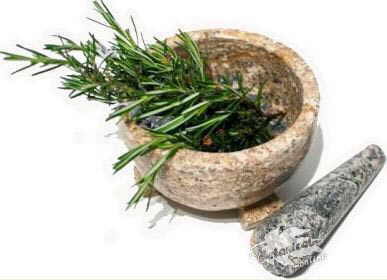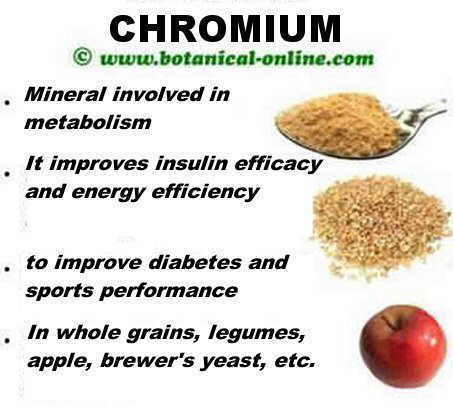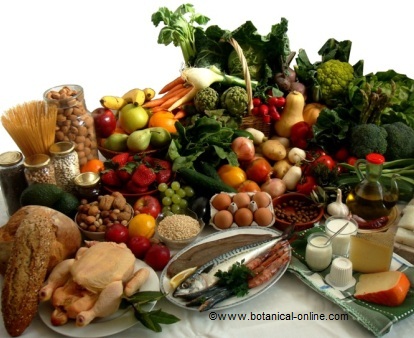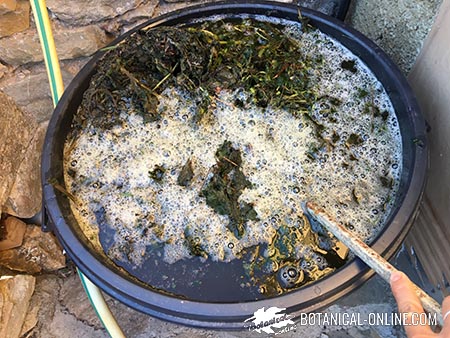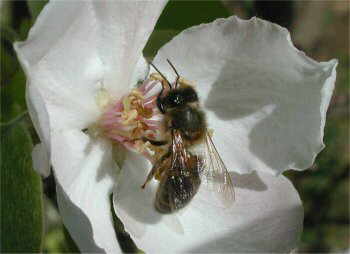Edible properties of blueberries
A food rich in anthocyanins and other antioxidant compounds
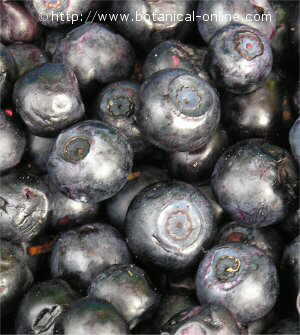
The main virtue of this food is their content of antioxidant compounds. Amongst them anthocyanidin flavonoids or anthocyanins. Blueberries are rich in cyanidin, delphinidin, malvidin, peonidin and petunidin:
- Malvidin is reaching the highest proportion in the fruit and appears in very large amount in other foods such as bananas, pomegranates or grapes. This pigment is responsible for the dark coloring of red wine and blueberry dark blue.
- Delphinidin occupies the second position. It has a bluish-red color, responsible for the blue tones of some flowers such as violets, borage or peculiar color or Cabernet wine Sugvignon. Some foods such as eggplant or black currants also contain this same principle.
- Cyanidin is the third component in order of importance. It appears in the skin of many fruits such as blueberries, blackberries, cherries, raspberries, apples, plums, etc. Found in some vegetables like red cabbage.
- Petunidin ranks fourth and is a component that provides the color of the flowers of some varieties of petunias.
- Peonidin occupies fifth place, a pigment that varies from reddish-purple to blue, which appears in the peony flowers, and other flowers such as sweet pea or violet tricolor. This pigment, which is also present in many berries, in a tone varies according to soil pH, so that changes from purple (pH 2) of the blue, pH 8. It is the same component that gives color to the ipomomea.
Properties of blueberry anthocyanins
Among the main virtues that we should highlight of anthocyanins, we have to include its anti-inflammatory properties, capable of neutralizing the inflammatory effects of histamine and prostaglandins exert on body tissues. Eating generous portions of blueberries will be very convenient for people with arthritis, allergies, asthma, rheumatism and other inflammatory processes.
Another property of these components is their ability to fluidify the blood, and preserve the integrity of the collagen of arteries, strengthening the arteries and capillaries and improving blood circulation. Because of its antiplatelet properties, it prevents the formation of thrombi or help to dissolve them. This is especially interesting for people with a tendency to have poor circulation. Eating this fruit improves the health of people with varicose veins or the appearance of superficial veins, arteriosclerosis, cholesterol, hemorrhoids or heart problems.
Other components in blueberries
Not less important for eye health are the antioxidants in this fruit. It has been shown that eating these fruits in abundance or drinking cranberry juice will help preserve vision in better state. It is particularly important to increase the capacity of vision in people with night blindness or those who have trouble adapting to abrupt changes between light and shadow.
In addition to anthocyanidins, blueberries are rich in other flavonoids (epicatechin, quercetin and myricetin). They all contribute to establish this fruit as one of the best antioxidants, capable of preventing the oxidation damage in the body.
Blueberries also contain vitamin C, another important antioxidant that also helps to solve many of the anomalies mentioned above. (See more properties of vitamin C in the comprehensive study of this vitamin)
A food for improving the brain
There have been studies on animals which have concluded that due to the antioxidant properties, the fruit is able to improve mental capacity and preserve the neurons of the process of degeneration that occurs over the years.
Animals that ate large amounts of blueberries had a higher ability to learn and solve problems more easily. This same experiment has led many researchers to believe that these same benefits may occur in humans. Thus a diet that includes these fruits could be useful in the prevention of mental illnesses such as Alzheimer’s could benefit people with memory loss problems, low mental concentration, dementia, etc.
What is clear is that the brain needs sugar to perform at its best and blueberries contain many sugars as fructose, glucose and sucrose. They provide a lot of energy and are very interesting not only to enhance the intellectual activity of students and people in general, but are a good source of energy to cope with the daily effort.
The sugars contained in this fruit get into the bloodstream in a gradual way, so it keeps sugar levels in the blood constant. So it is a fruit that is appropriate for people with diabetes.
For its content in myrtillin, inositol, pectin, fructose, rutin and ascorbic acid, this fruit is considered as a good anti-diabetic and it is thought that it could have positive effects in people with diabetes mellitus, non-insulin-dependent, ie those who have developed the disease as adults.
A food for dieting
Blueberries contain lots of water and very little fat. They are food with few calories. In addition, they contain many diuretic components, including ascorbic, caffeic, chlorogenic and ursolic acids; arbutin, magnesium and potassium. Eating blueberries will increase urination and help eliminate retained fluids. At the same time help to “fill the stomach” increasing the sensation of satiety.
The sugars contained in this fruit have a gradual absorption so they help to alleviate hunger and helps us to avoid resorting to higher-calorie foods. Therefore we recommend regular consumption of blueberries in people wishing to make a diet to lose weight.
It is a bowel regulator that is able -simultaneously- to prevent constipation and stop diarrhea. Its fiber content gives it laxative properties and its tannin content makes it a good astringent. We will eat the young fruit if we are constipated, while it is best to eat them dry if we are “too loose.”
A food for cancer prevention.
Due its content of antioxidants and fiber, this fruit, like most of the berries, is ideal for preventing colon cancer. Antioxidants neutralize the action of potentially cancerous particles on the walls of the intestine.
The fiber content increases fecal mass so get evacuated more rapidly without damaging particles. On the other hand, we have to consider that this fruit is rich in pectin, a type of soluble fiber, that involves not allowing these toxins to be absorbed by the intestine.
These fruits contain kaemferol, a flavonoid, whose positive health effects have been tested in numerous studies. Besides lowering the risk of heart attack, this component inhibits the growth of cancer cells in the ovary.
Moreover, this plant is one of the richest in chlorogenic acid, after coffee, sunflower or nettles. This component has many medicinal properties, including anticarcinogenic properties, ie has the ability to inhibit the growth of cancer cells, especially those of the stomach, liver, colon and skin.
It is particularly active in the neutralization of nitrosamines that nitrates added to food produced in the body. Nitrosamines are highly toxic and are one of the compounds largely responsible for the appearance of many types of cancer. Apart from its chlorogenic acidcontent, this berry also contains p-coumaric acid, which is another major antinitrosaminic component.
What are the best blueberries?
The best blueberries are those who are bought freshly grown or harvested in the field. People who have the fortune to live in places where they grow wild should pick the fruit themselves.
Fresh blueberries are distinguished from those who have been frozen because of a white layer above the skin, like a small pile that melts when rubbed with the fingers. It is important, when you bring them home, to wash them thoroughly so as to remove any parasites or organisms that they may have.
They can be eaten fresh, on their own or combined with other berries or fruits. They are delicious when served with a little cream.
If you’re going to buy them at the market, they can be found during the summer. The best blueberries are the Scandinavian and Central Europe ones. We can also buy them from eastern Europe. These have lower prices but do not have as much quality as the first ones.
It is important to buy those that are well turgid, with no moisture or juice. If we press them a little and or fingers “sink” in them, or if we find them soft, or notice liquid coming from them, they are too mature and will rot very soon.
How to eat blueberries
There are different ways of eating blueberries. The most common ones are:
- Fresh blueberries: This is the most recommended way of eating this fruit. They should be eaten quickly as they can not stay fresh for too long. It’s better to freeze the ones that are not going to be eaten immediately. They can last up to 20 days if frozen. If we have them in the fridge, it is better to take them a while before meals, because they should not be cold in order to appreciate their full flavor.
- Blueberry jam: It is very tasty though many of the principles of fresh blueberries are lost in the cooking process. The jelly can be eaten at breakfast, over toast, it can be used to sweeten the yogurt, to fill crepes or for making cakes or pastries. We can buy canned blueberries.
- Dry blueberries: If we decide to dry the blueberries, this is a state in which most of the properties are retained, although they are far less tasty.
- Blueberry juice: Another interesting option is to grind them in a blender to turn them into juice. This juice is delicious and has wonderful properties for the urinary system due to its hippuric acid content, a natural antibiotic for many bacteria in the urinary tract. (See more information in the section “Medicinal properties of cranberry” in the listing below).
| Composition of fresh blueberriesper 100 g | |
| Water | 84, 21 g |
| Calories | 60 Kcal |
| Fats | 0,33 g |
| Protein | 0, 74 g |
| Carbohydrates | 14, 49 g |
| Fiber | 2, 4 g |
| Potassium | 88 mg |
| Sodium | 1 mg |
| Phosphorus | 12 mg |
| Calcium | 12 mg |
| Copper | 0,06 mg |
| Magnesium | 6 mg |
| Manganese | 0, 34 mg |
| Iron | 1 mg |
| Zinc | 0, 16 mg |
| Selenium | 0, 10 mg |
| Vitamin C | 13 mg |
| Vitamin B1 (thiamine) | 0, 04 mg |
| Vitamin B2 (Riboflavin) | 0, 04 mg |
| Niacin | 0, 42 mg |
| Folacin | 6 mcg |
| Vitamin B6 | 0, 05 mg |
| Vitamin A | 54 IU |
| Vitamin E | 0, 57 mg |
![]() More information on blueberries.
More information on blueberries.

